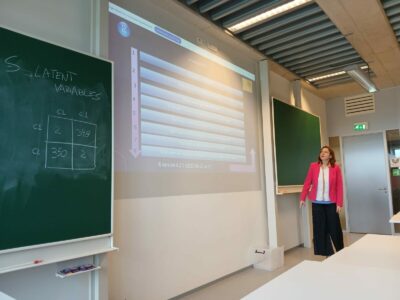Home » Publicaties » Lecture on #NIR and #Chemometrics for master’s students at Wageningen University & Research
Lecture on #NIR and #Chemometrics for master’s students at Wageningen University & Research
On March 26th, 2025, I had the honor of delivering Lecture 10 on Quality Detection Using #NIR and #Chemometrics for master’s students at Wageningen University & Research. This course, organized by Silvia Langer, provided a fantastic opportunity to introduce students to the fascinating intersection of NIR spectroscopy and chemometrics.
I truly enjoyed diving deep into the theoretical aspects of NIR, an area often overshadowed by the fast pace of industrial applications. University is, without a doubt, the perfect place to pause, reflect, and really explore the theory behind these complex topics.
Throughout the class, we covered fundamental questions such as: What is light? How is light formed? How does it move? Which part of light interacts with matter? We also explored molecular behavior, including what defines a normal mode of vibration, and the conditions that allow a molecule to absorb infrared energy. I explained the relationship between molecular vibrations and Hooke’s Law, and how this theory extends to the anharmonic model when vibrations are large enough to deviate from linear behavior.
A fascinating part of our session involved exploring cases where different infrared absorption bands are observed compared to those predicted by normal mode calculations. This was an intriguing point for further reflection and sparked some interesting discussions.
We also went in-depth into the stages of chemometric modeling, studied relevant case studies, and concluded with a look at the emerging trends in deep learning and artificial neural networks (ANN) in chemometrics. These technologies are rapidly transforming the field of quality detection, and it was exciting to see the students’ curiosity grow as we explored their potential.
It was a pleasure to share these insights and engage with such an enthusiastic group of students. I’m looking forward to more opportunities to collaborate and teach in the future!
I truly enjoyed diving deep into the theoretical aspects of NIR, an area often overshadowed by the fast pace of industrial applications. University is, without a doubt, the perfect place to pause, reflect, and really explore the theory behind these complex topics.
University is, without a doubt, the perfect place to pause, reflect, and really explore the theory behind these complex topics.
Throughout the class, we covered fundamental questions such as: What is light? How is light formed? How does it move? Which part of light interacts with matter? We also explored molecular behavior, including what defines a normal mode of vibration, and the conditions that allow a molecule to absorb infrared energy. I explained the relationship between molecular vibrations and Hooke’s Law, and how this theory extends to the anharmonic model when vibrations are large enough to deviate from linear behavior.
A fascinating part of our session involved exploring cases where different infrared absorption bands are observed compared to those predicted by normal mode calculations. This was an intriguing point for further reflection and sparked some interesting discussions.
We also went in-depth into the stages of chemometric modeling, studied relevant case studies, and concluded with a look at the emerging trends in deep learning and artificial neural networks (ANN) in chemometrics. These technologies are rapidly transforming the field of quality detection, and it was exciting to see the students’ curiosity grow as we explored their potential.
It was a pleasure to share these insights and engage with such an enthusiastic group of students. I’m looking forward to more opportunities to collaborate and teach in the future!
hashtag#Chemometrics hashtag#spectroscopy hashtag#DeepLearning hashtag#ArtificialNeuralNetworks hashtag#WageningenUniversity hashtag#DataScience hashtag#QualityDetection hashtag#Teaching hashtag#Research hashtag#Innovation Wageningen Food & Biobased Research